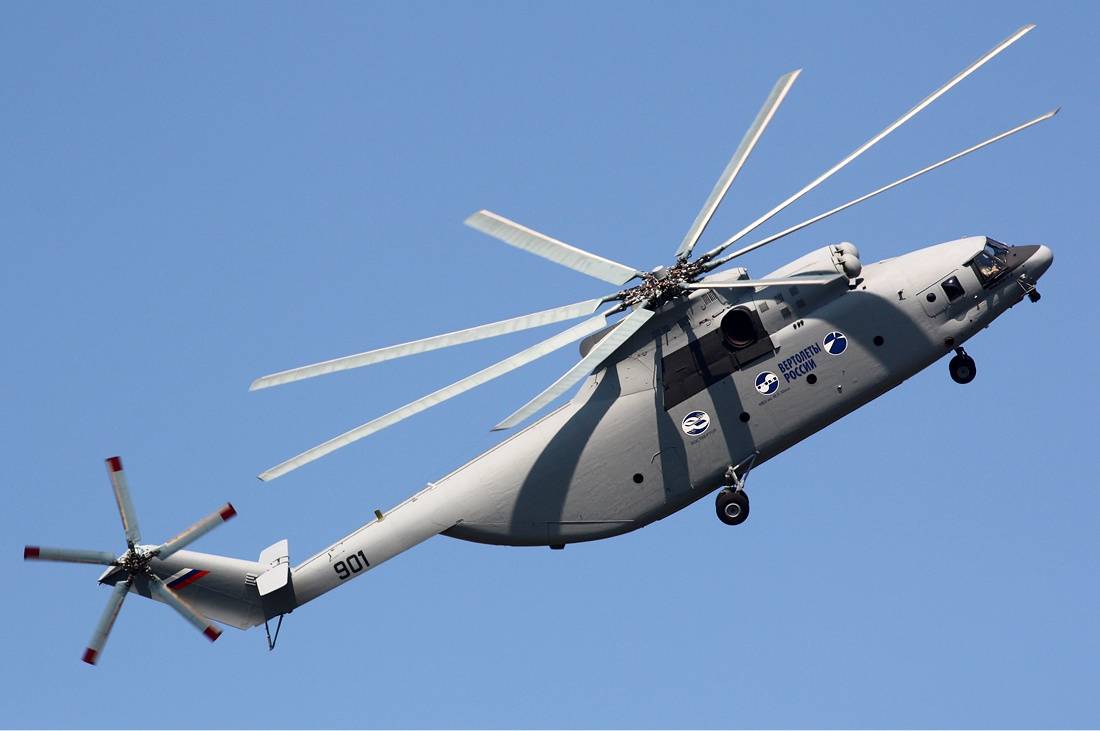Russian Helicopters has launched series production on the heavy Mi-26T2 helicopter at Rostvertol. The Mi-26T2 is a modernised version of the Mi-26T, equipped with the latest avionics, making it possible to cut the number of crew required and also to operate the helicopter during night-time.
“We announce the start of production on the modernized heavy Mi-26T2 helicopter,” said delegation head, deputy CEO of Russian Helicopters Andrey Shibitov. “Mi-26 helicopters are unparalleled in terms of their flight capabilities, and this modernization significantly expands their potential operational use. I am confident that the Mi-26T2 will be popular in Russia and internationally.”
Creating heavy helicopters poses particularly complex design challenges, and Russia has immense, unique experience developing and producing these machines. For example, it was Mil Moscow Helicopter Plant that developed the Mi-6 heavy helicopter, which was produced at Rostov on Don from 1959 to 1980. The Mil Moscow Design Bureau also developed the unique V-12 (Mi-12) heavy helicopter, which was not put into series production for economic reasons.
The military Mi-26 helicopter and its commercial variant Mi-26T have been produced at Rostvertol from 1980 right up until the present day, and these machines have proven themselves in all areas of their operation. The helicopter has set cargo transportation records – the Mi-26T can carry a cargo of 20 tonnes inside its cabin or on an external sling.
Complex modernization of the Mi-26T into the Mi-26T2 was implemented by Mil Moscow Helicopter Plant jointly with Rostvertol, under Russian Helicopters auspices. The preparation of design and operational documentation for the helicopter concluded in 2010. Rostvertol was simultaneously developing an improved Mi-26T in the form of the modernized prototype Mi-26T2.
In December 2010, the Mi-26T2 prototype was transferred from the final assembly workshop at Rostvertol to the flight test center for delivery acceptance and final ground and flight tests, which concluded in 2011.
On 17 February 2011, the modernized Mi-26T2 helicopter completed its first flight at Rostvertol. That March, ground and flight demonstrations of the Mi-26T2 were given for international delegations. In August 2011, the helicopter was showcased at the MAKS-2011 airshow and sparked significant interest among visitors and potential customers.
In 2013, a major delivery contract for the Mi-26T2 was concluded with a foreign country, and Mil Moscow Helicopter Plant started developing design documentation to meet this customer’s particular requirements. Throughout 2014, Mil Moscow Helicopter Plant carried out preliminary and special flight tests on the Mi-26T2 prototype. The necessary working design documentation is currently being prepared ahead of launching series production of the Mi-26T2. The modernized Mi-26T2 helicopter meets the latest standards in international aircraft construction. Crew numbers are reduced from 5 to 2-3 people.
The Mi-26T2’s design, equipment, and systems mean that it can be operated at any time of day or night, in regular or difficult weather conditions, over even ground or in mountainous areas. Like the Mi-26T, this new helicopter does not need to be maintained or serviced at an airfield, and can be based autonomously for long periods of time.
The Mi-26T2 is equipped with a glass cabin, five multifunction LCD displays, control board, duplicate electromechanical instruments, and an upgraded digital communications suite. On-board video displays offer clear visuals of the cargo on the external sling during the day.
The Mi-26T2’s navigation suite significantly increases the extent of flight control automation, easing the crew’s role. The Mi-26T2 boasts enhanced safety. Its early ground proximity warning systems alert crew if the helicopter is nearing the ground. The in-flight situation, obstacle and collision warning system identifies possible collisions and gives clear control over airspace to a radius of 9-11 km around the helicopter, sending requests to all aircraft in this area.
For in-flight comfort at low or high temperatures, the helicopter is equipped with air conditioning and heating systems in the crew and cargo cabins.
The helicopter is equipped with special features to ease the loading and unloading of the transport cabin. Like its predecessor, the Mi-26T, the Mi-26T2 can be used to transport large sized cargo and equipment in the cargo cabin or on an external swing, to transport paratroopers, or the wounded. This helicopter can be used to carry out a variety of construction and assembly work, and can also be used to deliver fuel (kerosene, diesel fuel), for the autonomous ground-based refueling of a range of aircraft and other vehicles, in addition to its fire-fighting capabilities.
Rostvertol, a Russian Helicopters company, produces a wide range of Mi- helicopters and carries out repair and modernization work on helicopters, supplies aviation engineering materials and provides related services. Currently Rostvertol is involved in the series production of new generation military helicopter Mi-28N Night Hunter (Mi-28NE export variant); the Mi-35M combat support helicopter; and the world’s heaviest multirole transport helicopter – the Mi-26T.
Russian Helicopters, (part of State Corporation Rostec), is one of the global leaders in helicopter production and the only helicopter design and production powerhouse in Russia. Russian Helicopters was founded in 2007 and is headquartered in Moscow. In 2014 its IFRS revenues increased 22,8% to RUB 169,8 billion. Deliveries reached 271 helicopters.










